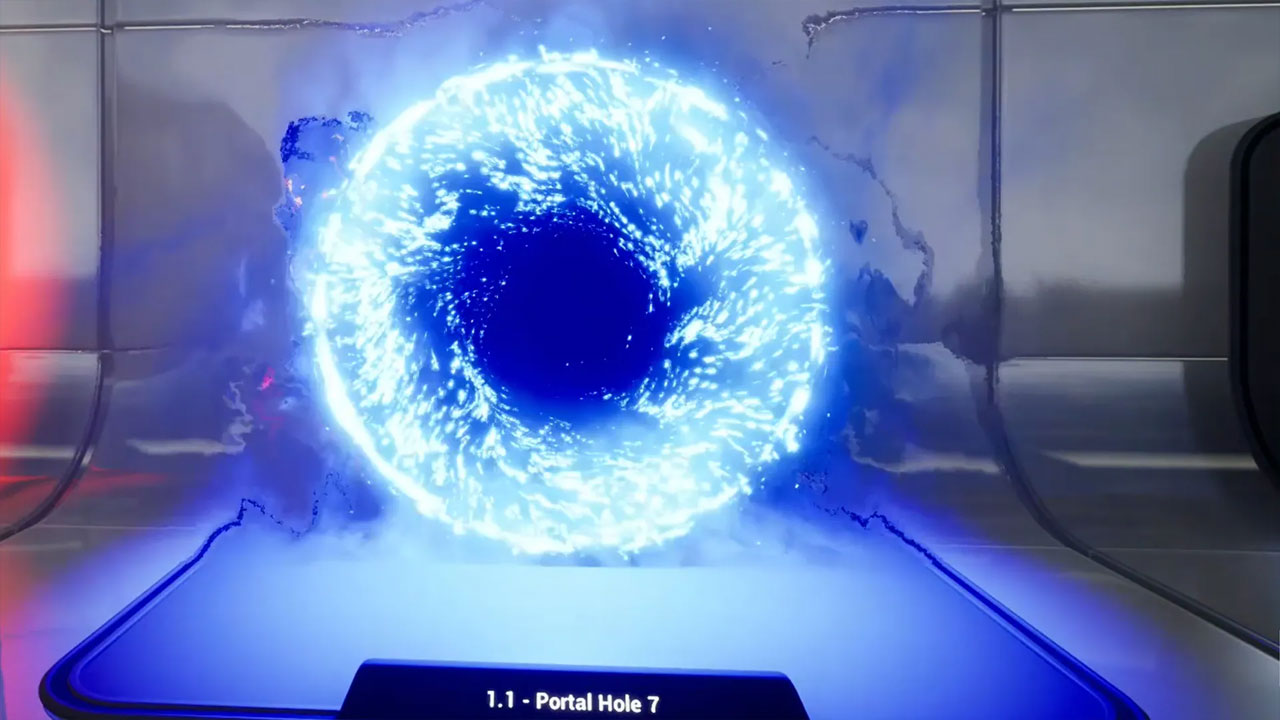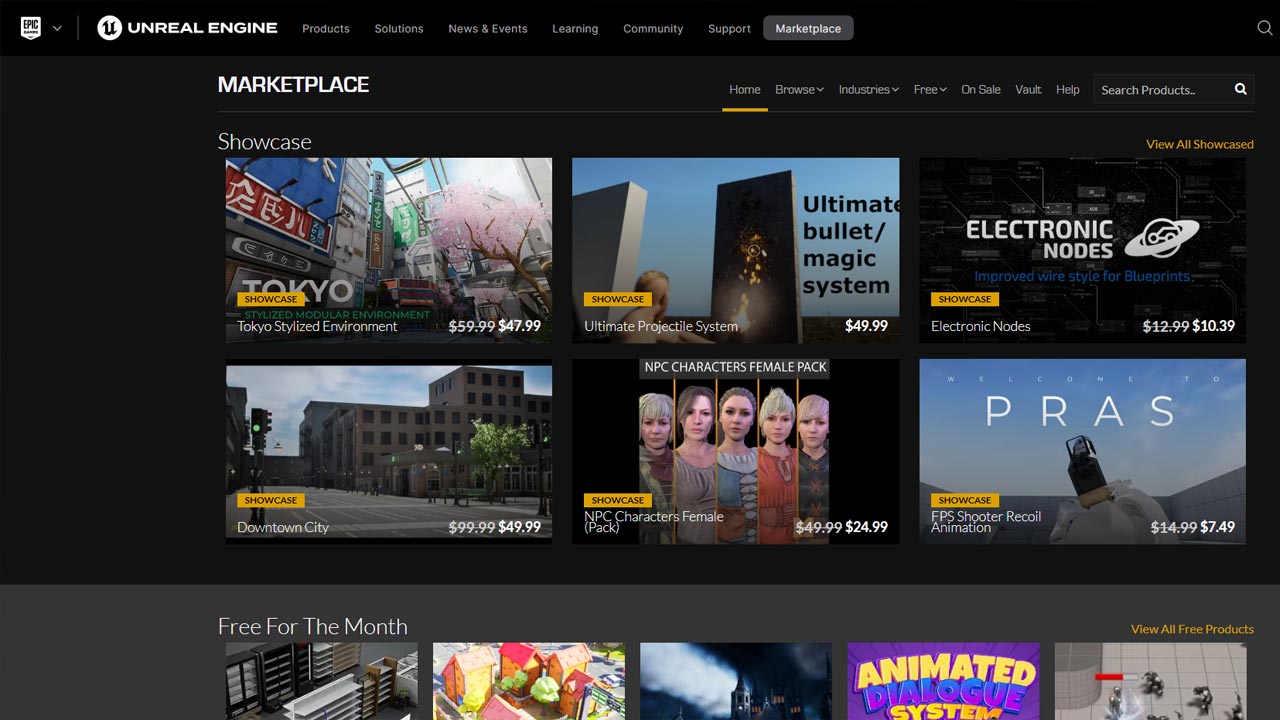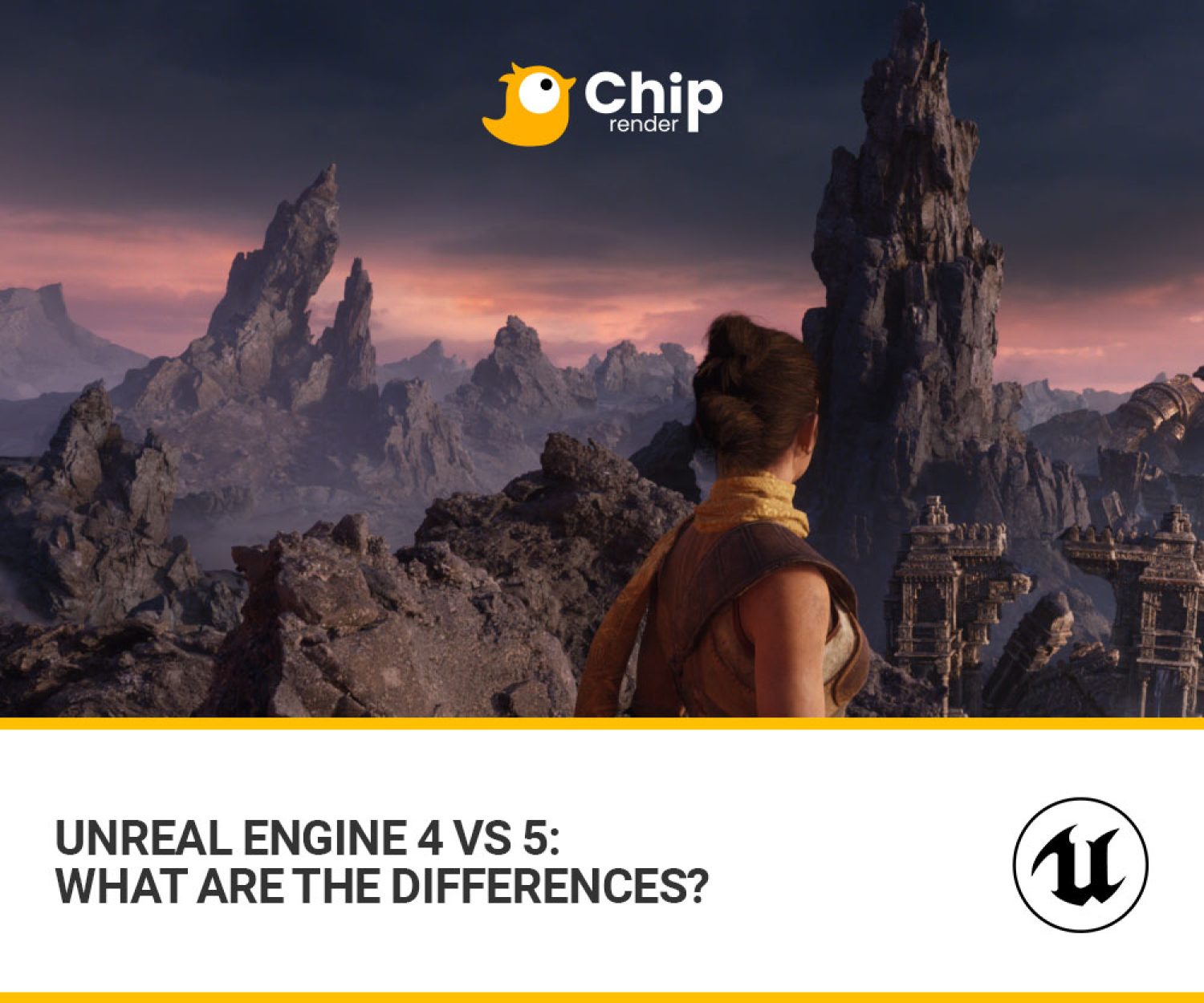Discover what is Unreal Engine and Everything you need to know about it.
It seems everyone now is obsessed with Unreal Engine (UE, for short). UE has always been a popular engine for years for mainstream games. But now, other than developers and AAA companies, many 3D creators are turning to the real-time application.
So, in this post, Chip Render goes into detail on what is Unreal Engine, and everything you need to know about this powerful real-time game engine.
What is Unreal Engine?
Unreal Engine, which is also known as UE, is a game engine developed by Epic Games, a video game and software development company. It was first showcased as a first-person shooter video game in 1998. Right now, it has been used in a variety of genres of games and has seen adoption by other industries, including the film and television industry.
Epic Games states that “Unreal Engine is the world’s most open and advanced real-time 3D creation tool for photoreal visuals and immersive experiences”.
With this tool, you can bring amazing real-time experiences to life, from first projects to the most demanding challenges. UE’s free and accessible resources and inspirational community empower everyone to realize their ambitions.
What is Unreal Engine used for?
Unreal Engine has been adopted across industries, such as:
- Games.
- Film and Television.
- Architecture.
- Automotive and Transportation.
- Broadcast and live events.
- Simulations, and more.
Creators across the industries above use UE to deliver cutting-edge content, interactive experiences, and immersive virtual worlds.
What are Unreal Engine features?
Unreal Engine provides all features – everything you need to start, grow, and stand out from your competitors. You can use it for any project, from design visualizations and cinematic experiences to high-quality games for PC, console, mobile, VR, and AR.
Let’s take a look at UE’s key features in each aspect.
1. Pipeline integration
- Support for industry standards such as FBX, USD, and Alembic allows you to connect to any media production pipeline.
- Python scripting in the Unreal Editor enables you to integrate Unreal Engine into your pipeline and automate your workflows.
- Convert data seamlessly at high fidelity with Datasmith, from a whole host of DCC, CAD, and BIM formats. For example, 3ds Max, Revit, SketchUp Pro, Cinema 4D, Rhino, SolidWorks, Catia, and more.
- Visual Dataprep: You can easily automate data preparation workflows with a simplified visual tool, even if you’re not a programmer.
- ShotGrid integration allows your team to work together across separate content creation tools.
- LiDAR point cloud support: Visualizes locations and gives accurate context to newly designed elements.
2. Worldbuilding
- Unreal Editor: An integrated development environment for authoring content and developing game level. It is available across platforms: Linux, macOS, and Windows.
- Modeling, UVs, and baking: A selection of extensive and robust creation and editing tools enables you to refine and iterate on assets, without a DCC package.
- Landscape and terrain tools: Create massive-scale open-world environments and terrains.
- Scalable foliage: Create different types of grass, flowers, small rocks, trees, bushes, and more.
- World Partition: Makes the creation of open worlds faster and easier by automatically dividing the world into a grid and streaming only the necessary cells.

World Partition in Fortnite. Image by Unreal Engine.
- Procedural Content Generation Framework: Define rules and parameters to populate large scenes.
- Asset optimization: Several tools to prepare and optimize a complex model for better real-time performance.
- Sky, cloud, and environment lighting: Author and render realistic or stylized skies, clouds, and other atmospheric effects with full artistic freedom.
- Water system: Create believable bodies of water within your landscapes.
3. Character and animation
- Animation Blueprints: Create and control complex animation behaviors.
- Machine Learning (ML) Deformer enables you to simulate film-quality deformations, such as flexing muscles, bulging veins, and sliding skin.
- Character animation authoring: Quickly and easily create rigs and share them across multiple characters, and then pose and animate them with artist-friendly tools.
- Live Link data streaming: The Live Link plugin enables you to connect a stream of real-time data from an external source to Unreal Engine.
- Take Recorder: Quickly iterate on performance recordings, and easily review previous takes.
- Character retargeting: Easily reuse existing animations, even across characters with different skeletons and proportions such as a human and a wolf.
- Sequencer nonlinear editing and animation: A fully nonlinear, real-time cinematic editing and animation tool built for collaboration.
- Runtime animation tools: Augment authored animation sequences at runtime to compensate for different gameplay scenarios.
4. Lighting, materials, and rendering
- Nanite & Virtual Shadow Maps: Create games and experiences with massive amounts of geometric detail.
- Virtual Texturing: Two methods to enable support for very large textures by dividing them into small tiles and only loading the visible tiles.
- Lumen: A fully dynamic global illumination and reflection solution.

Lumen dynamic global illumination. Image by Unreal Engine.
- Photoreal ray tracing in real time: Achieve Hollywood-quality visuals out of the box with Unreal Engine’s physically based hybrid ray tracer.
- Temporal Super Resolution (TSR) enables the engine to render at a much lower resolution but with similar output pixel fidelity to frames rendered at a higher resolution.
- Flexible Material Editor: Enjoy unprecedented control over the look and feel of characters and objects.
- Path Tracer: A DXR-accelerated, physically accurate progressive rendering mode.
- Sophisticated lighting: Create realistic interior and exterior lighting effects while maintaining real-time performance, with a wide range of advanced lighting tools.
- Post-process and screen-space effects: A range of film-quality post-processing effects to adjust the overall look and feel of your scene. Achieve screen-space realistic effects while minimizing cost.
- Color-accurate final output: Many tools to ensure consistent color throughout the pipeline.
- Movie Render Queue: Create high-quality media without post-processing, thanks to the ability to render movies and stills with accumulated anti-aliasing and motion blur.
- Forward Shading Renderer provides a faster baseline, with faster rendering passes, which may lead to better performance on VR platforms and certain consoles such as the Nintendo Switch.
- Advanced shading models: Produce more realistic results on a wide range of objects and surfaces.
5. Simulation and effects
- Niagara particles and visual effects: Create film-quality levels of VFX polish in real time for effects such as fire, smoke, dust, and water.

Niagara VFX. Image by Unreal Engine.
- Clothing tools: Simulate clothing and other fabrics with the Chaos physics solver.
- Chaos physics and destruction system: Fracture, shatter, and demolish massive-scale scenes at cinematic quality with unprecedented levels of artistic control.
- Strand-based hair and fur: Simulate and render hundreds of thousands of photoreal hairs at up to real-time speeds from grooms created in DCC packages.
6. Gameplay and interactive authoring
- Robust multiplayer support: Produce some of the industry’s most compelling multiplayer experiences.
- Advanced artificial intelligence (AI): Give AI-controlled characters increased spatial awareness of the world around them and enable them to make smarter movements.
- Variant Manager: Create and edit variants of your asset that include options for visibility, transforms, and material assignments, and activate or deactivate them in the Unreal Editor or at runtime.
- Blueprint visual scripting system: Rapidly prototype and ship interactive content without touching a line of code.
- Unreal Motion Graphics UI Designer (UMG): Create UI elements such as in-game/in-application HUDs, menus, or other interface-related graphics you wish to present to your users.
- Gameplay frameworks: Create large systems with huge numbers of elements; complex input handling, runtime control remapping, and more.
7. Integrated media support
- Professional video I/O support and playback: 4K UHD video and audio I/O at high bit depths and frame rates on a range of AJA Video Systems and Blackmagic cards.
- Unreal Audio Engine: Enhance your project’s audio with a rich audio feature set.
- MetaSounds: A high-performance system that offers complete control over audio DSP graph generation of sound sources.
- Media Framework enables the playback of videos inside Unreal Engine.
8. Virtual production
- In-Camera VFX Editor: Presents a streamlined UI/UX for performing common stage operations tasks.
- Remote control protocols and web UI builder: Easily create custom UIs that enable users to make settings from any device that hosts a web browser.
- Efficient multi-display rendering: Render real-time content at any resolution, and display it on multiple physical or projected screens. Render multiple instances of Unreal Engine running on a single workstation or across multiple GPUs.
- Virtual Camera system: Cinematographers working in a virtual production environment can drive cameras in Unreal Engine using an iPad Pro.
- Level Snapshots: Record the current state of a scene in a snapshot, and later restore it in its entirety, or selectively choose which elements to restore.
- Virtual Scouting for filmmakers: use VR to explore the world, determine scene blocking, and compose shots to make better creative decisions.
9. Content
- Marketplace: Thousands of high-quality assets and plugins to accelerate production and bring new functionality to your work.

Unreal Engine Marketplace
- Industry-specific templates: A variety of useful templates help you find the right starting point for your project and achieve your intended result in the shortest possible time.
- Quixel Megascans: Every Unreal Engine license comes with free access to the entire Quixel Megascans library for use in Unreal Engine.
- Sample projects: Explore, adapt, and learn from over 20 sample projects included with Unreal Engine, and speed for your own projects in less time.
10. Developer tools
- Full access to C++ source code: study, customize, extend, and debug the entire Unreal Engine, and complete your project without obstruction.
- Seamless Perforce integration: Many version control commands directly into the Content Browser.
- Profiling and performance: Profile, analyze, and optimize your project for real-time performance by identifying and removing bottlenecks.
- C++ API: Add new classes to extend Unreal Engine’s functionality.
- Oodle and Bink: Fast, efficient compression and encoding tools.
11. Platform support
- Multi-platform development.
- Containers.
- XR (AR, VR, and MR) support.
- Pixel Streaming.
FAQ - What is Unreal Engine?
1. Is Unreal Engine free?
Yes, Unreal Engine is free.
You can use Unreal Engine for learning, developing your own projects, and even distributing commercial projects without paying any fees to Epic Games. That includes custom projects delivered to clients, linear content (such as films and television shows), and any product that earns no revenue or whose revenue falls below the royalty threshold – $1 million.
A 5% royalty only kicks in if and when your product earns over $1 million. In this case, the first $1 million remains royalty-exempt.
However, there are two other licensing options for your use of Unreal Engine.
- Enterprise program: $1500 per seat per year.
- Custom license: Negotiable.
2. What language does Unreal Engine use?
Unreal Engine uses C++ as the programming language for developing 3D games within the tool. It also provides a visual scripting system called Blueprints, which allows developers to create gameplay elements without writing code.
And when building your actual game code, you use a combination of both C++ and Blueprint.
3. Who owns Unreal Engine?
Unreal Engine is owned and developed by Epic Games, a leading interactive entertainment company and provider of 3D engine technology. Epic Games was founded in 1991 with Corporate Headquarters in Cary, North Carolina.
The original version of the game engine was developed by Tim Sweeney, the founder and CEO of Epic Games.
4. What are Unreal Engine system requirements?
Find out the minimum and recommended Unreal Engine system requirements in this post.
Some of the new features will require higher-end hardware to get the best results.
- To get the most out of Nanite, Virtual Shadow Maps, and Lumen, you should use an NVIDIA GTX 1080 or AMD VEGA 64 or higher graphics card.
- For hardware ray tracing with Lumen, it is recommended to use an NVIDIA RTX 20 series or AMD RX 6000 series graphics card or higher.
- You also should always upgrade to the latest drivers for your GPU.
5. What platforms does Unreal Engine support?
You can run the Unreal Editor on Windows, macOS, and Linux.
Unreal Engine enables you to deploy projects to Windows PC, PlayStation 5, PlayStation 4, Xbox Series X, Xbox Series S, Xbox One, Nintendo Switch, macOS, iOS, Android, ARKit, ARCore, OpenXR, SteamVR, Oculus, Linux, and SteamDeck.
 Chip Render Farm is one of the few cloud rendering services that support Unreal Engine. With our powerful IaaS model and 1/2/4 x GPU RTX 3090 servers, you will be able to speed up your UE projects several times. Join Chip Render now and have your own Cloud Workstation from only $2.9.
Chip Render Farm is one of the few cloud rendering services that support Unreal Engine. With our powerful IaaS model and 1/2/4 x GPU RTX 3090 servers, you will be able to speed up your UE projects several times. Join Chip Render now and have your own Cloud Workstation from only $2.9.




